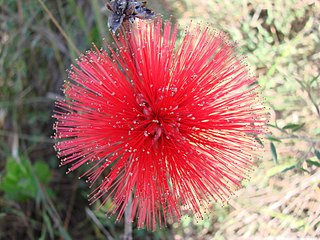
Calliandra is a genus of flowering plants in the pea family, Fabaceae, in the mimosoid clade of the subfamily Caesalpinioideae. It contains about 140 species that are native to tropical and subtropical regions of the Americas.

Calliandra brevipes, the pink powderpuff, is an attractive shrub with finely divided leaves and clusters of red powder-puff flowers. It is native to southeastern Brazil, Uruguay, and northern Argentina.

Calliandra eriophylla, commonly known as fairy duster, is a low spreading shrub which is native to deserts and arid grasslands in California, Arizona, New Mexico and Texas and Mexico.
Calliandra decrescens is a species of plant in the family Fabaceae. It is found only in Peru.

Calliandra californica, the Baja fairy duster, is an evergreen, woody shrub which is native to Baja California, Mexico. In Spanish, the plant is also known vernacularly as tabardillo,zapotillo or chuparosa. The flowers, which appear in early summer, have clusters of red stamens. The shrub is usually between 0.6 and 1.8 metres in height and has bipinnate leaves. The leaves have been described as "fern-like." Leaves close at night time.
Calliandra bella is a species of flowering plants of the genus Calliandra in family Fabaceae.
Calliandra chilensis is a species of flowering plants of the genus Calliandra in the family Fabaceae.
Calliandra conferta is a species of flowering plants of the genus Calliandra in the family Fabaceae.
Calliandra cruegeri is a species of flowering plants of the genus Calliandra in the family Fabaceae.

Calliandra dysantha is a species of flowering plants of the genus Calliandra in the family Fabaceae. Is native to Brazil.
Calliandra erubescens is a species of flowering plants of the genus Calliandra in the family Fabaceae.
Calliandra foliolosa is a species of flowering plants of the genus Calliandra in the family Fabaceae.

Calliandra haematocephala is a species of flowering plants of the genus Calliandra in the family Fabaceae.

Calliandra houstoniana is a species of flowering plants of the genus Calliandra in the family Fabaceae.
Calliandra peninsularis is a species of flowering plants of the genus Calliandra in the family Fabaceae. It is endemic to Baja California Sur state in Mexico.
Calliandra physocalyx is a species of flowering plants of the genus Calliandra in the family Fabaceae, endemic to southwestern Mexico. It is a shrub with pink-and-white or pink-and-red flowers. Like other members of the genus Calliandra, the filaments of the stamens are long and colourful, in this case about 7.5 centimetres (3.0 in) long. The species was first scientifically described in 1988.

Calliandra tweediei is a species of flowering plants of the genus Calliandra in the family Fabaceae.
Calliandra elegans is a plant species in the genus Calliandra found in Brazil.

Calliandra calothyrsus is a small leguminous tree or large shrub in the family Fabaceae. It is native to the tropics of Central America where its typical habitat is wet tropical forests or seasonally dry forests with a dry season of four to seven months, when it may become deciduous. This tree grows to about 6 m (20 ft) and has pinnate compound leaves and flowers with a boss of prominent reddish-purple stamens. It is not very drought-tolerant and the above-ground parts are short-lived but the roots regularly resprout.
Calliandra erythrocephala is a species of flowering plants of the genus Calliandra in the family Fabaceae, endemic to southwestern Mexico. It is a small tree with bright red flowers. Like other members of the genus Calliandra, the filaments of the stamens are long and colourful, in this case about 4.5–5.5 centimetres (1.8–2.2 in) long. The species was first scientifically described in 1988.








